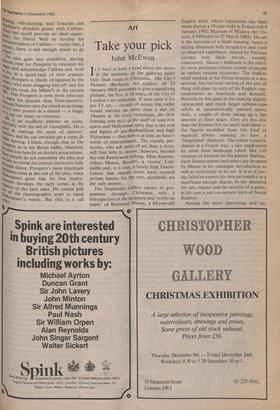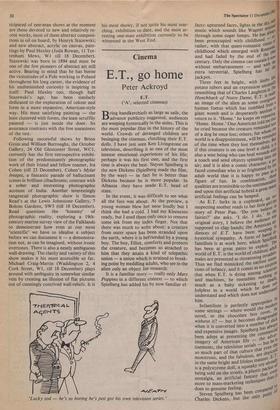Art
Take your pick
John McEwen
It is hard to keep a head above the shows at the moment, as the galleries make their final surge to Christmas. The City's Pictures (Barbican Art Gallery till 23 January 1983) presumes to give a tantalising glimpse, the first in 14 years, of the City of London's art collection. If your taste is for pre-TV art — records of events that today would warrant no more than a slot on Thames at Six (civic receptions, the river freezing over etc); or the stuff of soap-box opera and Hollywood epics that is the soul and legacy of pre-Raphaelitism and high Victoriana — then here is at least an hour's worth of entertainment. The visually par- ticular, who ask more of art than a story, will find little to savour., however, beyond the odd Rembrandt etching, Allan Ramsay, Albert Moore, Rossetti, a 'snowy' Con- stable and, it is true, a lovely little Fantin- Latour that should never have escaped private hands; for the rest, mothballs are the only answer.
carries its pro-
The Serpentine Galler}r
gramme through Christmas with a retrospective of the sculpture and 'works on paper' of Raymond Mason, a 60-year-old English artist whose reputation has been made during a 30-year exile in France (till 9 January 1983; Museum of Modern Art Ox- ford, 6 February to 27 March 1983). His art is the outcome of a Slade training, hence a lasting obsession with perspective and truth to observed experience, shaped by Parisian contact With Slade heroes, notably Giacometti. Mason's hallmark is the relief, his most persistent subject crowds of people in various routine situations. The shallow relief method of his Fifties bronzes is a less anxious, less tortured version of the sort of thing still done by such of his English con- temporaries as Auerbach and Kossoff. Recently he has gone in for making slightly caricatured and much larger tableau-type reliefs in naturalistically painted epoxy resin, a couple of them taking up a fair amount of floor space. They are less chic than the bronzes but no more individual — the figures modelled from this kind of material always seeming to have a 'fairground' character. The colour is pastel- shaded in a French way, a fact emphasised by some resin landscape reliefs like 3-D versions of pictures by the painter Balthus. Such famous names and others are dropped by Mason in his catalogue introduction as well as stylistically in his art. It is as if hav- ing failed to express his own personality to a significant enough degree, he has plumped for size, impact and the security of a genre, in his case a not too earnest form of Social Realism.
Among the more interesting and an- ticipated of one-man shows at the moment are those devoted to new and relatively re- cent works, most of them abstract composi- tions in oil on board, by Henryk Stazewski; and new abstract, acrylic on canvas, pain- tings by Paul Huxley (Juda Rowan, 11 Tot- tenham Mews, WI till 18 December). Stazewski was born in 1894 and must be one of the few pioneers of abstract art still active. Bearing in mind that he has borne the vicissitudes of a Pole working in Poland throughout his long career, the evidence of his undiminished curiosity is inspiring in itself. Paul Huxley too, though half Stazewski's age, has been similarly dedicated to the exploration of colour and form in a more expansive, American-style way. His most satisfying painting — the least cluttered with forms, the least scruffily painted — is just inside the door. Its assurance contrasts with the free uneasiness of the rest.
Following successful shows by Brion Gysin and William Burroughs, the October Gallery, 24 Old Gloucester Street, WC1, currently has the first retrospective exhibi- tion of the predominantly photographic work of their friend and fellow roamer, Ira Cohen (till 23 December). Cohen's Mylar Images, a fantastic parade of hallucinant scenes in brilliant cibachrome, contrast with a sober and interesting photographic account of India. Another interestingly tangential photographic show is Simon Read's at the Lewis Johnstone Gallery, 7 Bolton Gardens, SW5 (till 18 December). Read questions the 'honesty' of photographic reality, exploring a 19th- century marine survey view of the Falklands to demonstrate how even at our most 'scientific' we have to idealise a subject before we can document it — a demonstra- tion not, as can be imagined, without ironic overtones. There is also a neatly ambiguous wall-drawing. The clarity and variety of this show makes it his most accessible so far. Michael Craig-Martin (Waddington 2, 4 Cork Street, WI, till 18 December) plays around with ambiguity in somewhat similar vein by creating an illusion of flat pictures out of cunningly contrived wall-reliefs. It is
his most showy, if not quite his most sear- ching, exhibition to date, and the most ar- resting one-man exhibition currently to be witnessed in the West End.











































 Previous page
Previous page